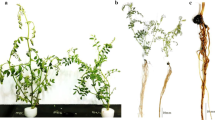Abstract
Phytophthora root rot, caused by Phytophthora medicaginis, is a major limitation to lucerne production but it can be managed through the use of resistant cultivars. Current resistance screening methods, using mature plants or post-emergence seedling assays, are costly and time consuming. The use of zoospore inoculum on detached leaves and intact cotyledons as an assay for plant resistance was assessed using genetically defined segregating populations. The detached leaf assay was a reproducible test, but this test could not be used for accurately predicting root ratings. The cotyledon tests using zoospores gave results at the population level that were indicative of the root responses of 19 cultivars and lines tested. The cotyledon reaction of individual plants also showed a strong association with root response. The cotyledon test, while not completely predictive of mature root responses, allowed the selection of Phytophthora resistant plants at a higher frequency than could be achieved by random selection.
Similar content being viewed by others
References
Bullen KS, Franzmann BA, Harris GA, Irwin JAG, Lloyd DL, Lowe KF, Mills WD, Ryley MJ, Thompson PJM (2002) ‘The lucerne management handbook (4th edn).’ (Information Series QI02032, Department of Primary Industries)
Erwin DC (1966) Varietal reaction of alfalfa to Phytophthora megasperma and variation in virulence of the causal fungus. Phytopathology 56, 653–657.
Erwin DC, Kennedy BW, Lehman WF (1959) Xylem necrosis and root rot of alfalfa associated with excessive irrigation and high temperatures. Phytopathology 49, 572–578.
Erwin DC, Ribeiro OK (1996) ‘Phytophthora diseases worldwide.’ (American Phytopathological Society Press: St Paul, Minnesota)
Faris MA (1985) Variability and interaction between alfalfa cultivars and isolates of Phytophthora megasperma. Phytopathology 75, 390–394.
Frosheiser FI, Barnes DK (1973) Field and greenhouse selection for Phytophthora root rot resistance in alfalfa. Crop Science 13, 735–738.
Hansen EM, Maxwell DP (1991) Species of the Phytophthora megasperma complex. Mycologia 83, 376–381.
Havey MJ, Maxwell DP, Irwin JAG (1987) Independent inheritance of genes conditioning resistance to Phytophthora megasperma from diploid and tetraploid alfalfa. Crop Science 27, 873–879.
Irwin JAG (1974) Reaction of lucerne cultivars to Phytophthora megasperma, the cause of root rot in Queensland. Australian Journal of Experimental Agriculture and Animal Husbandry 14, 561–565.
Irwin JAG, Lloyd DL, Lowe KF (2001) Lucerne biology and genetic improvement — an analysis of past activities and future goals in Australia. Australian Journal of Agricultural Research 52, 699–712.
Irwin JAG, Maxwell DP (1980) Resistance of Medicago species accessions to Phytophthora megasperma f. sp. medicaginis. Plant Disease 64, 396–397.
Irwin JAG, Maxwell DP, Bingham ET (1981) Inheritance of resistance to Phytophthora megasperma in tetraploid alfalfa. Crop Science 21, 277–283.
Irwin JAG, Maxwell DP, Smith RR (1980) Correlation between root and stem reaction of alfalfa to Phytophthora megasperma f. sp. medicaginis. Phytopathology 70, 987–990.
Irwin JAG, Miller SA, Maxwell DP (1979) Alfalfa seedling resistance to Phytophthora megasperma. Phytopathology 69, 1051–1055.
Liew ECY, Irwin JAG (1994) Comparative studies on Phytophthora megasperma isolates from chickpea collected in Australia and Spain. Mycological Research 98, 1284–1290.
Mitchell JE, Yang CY (1966) Factors affecting growth and development of Aphanomyces euteiches. Phytopathology 56, 917–922.
Nygaard SL, Grau CR (1989) Phytophthora megasperma virulence to alfalfa measured using single-isolate zoospore suspensions. Canadian Journal of Plant Pathology 11, 101–108.
Pearson CJ, Brown R, Collins WJ, Archer KA, Wood MS, Petersen C, Boothe B (1997) An Australian temperate pastures database. Australian Journal of Agricultural Research 48, 453–465.
Pratt RG, Mitchell JE, Willis DA (1975) Resistance and susceptibility to Phytophthora megasperma expressed in alfalfa cotyledons. Phytopathology 65, 365–369.
Sprent P (1993) ‘Applied nonparametric statistical methods (2nd edn).’ (Chapman & Hall: London)
Thies JA, Barnes DK (1991) Phytophthora root rot resistance. In ‘Standard tests to characterize alfalfa cultivars’. (Eds CC Fox, R Berberet, FA Gray, CR Grau, DL Jessen, MA Peterson) p. D8. (North American Alfalfa Improvement Conference)
Author information
Authors and Affiliations
Corresponding author
Rights and permissions
About this article
Cite this article
Irwin, J.A.G., Musial, J.M., Mackie, J.M. et al. Utility of cotyledon and detached leaf assays for assessing root reactions of lucerne to Phytophthora root rot caused by Phytophthora medicaginis . Australasian Plant Pathology 32, 263–268 (2003). https://doi.org/10.1071/AP03006
Received:
Accepted:
Issue Date:
DOI: https://doi.org/10.1071/AP03006




